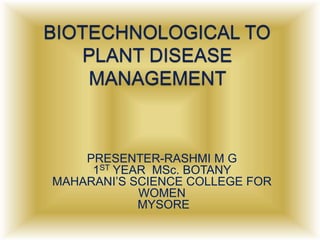
BIOTECHNOLOGICAL TO PLANT DISEASE MANAGEMENT.pptx
- 1. PRESENTER-RASHMI M G 1ST YEAR MSc. BOTANY MAHARANI’S SCIENCE COLLEGE FOR WOMEN MYSORE
- 2. According to Horsefall and Dimond (1959) the disease :- Is not a pathogen It is caused by a pathogen Is not the symptoms or effects seen on the plant, symptoms result from disease Is not a condition as the condition results from the disease Is not any injury which results from disease as well as from any traumatic cause Cannot be catching or infectious, it is actually the pathogen which is catching or transmitted They define disease as a malfunctioning process in thee plant body due to continuous irritation which results in some suffering It is the pathological process in plants and animals
- 3. The branch of science that deals with the study of nature, development and control of plat diseases is known as phytopathology The phytopathology has 4 main objectives- Etiology-concerns with causal organisms along with environmental conditions that cause diseases in plant Pathogenesis- actual mechanism of disease development and involves complex host-pathogen interactions Epidemiology- concerns the interaction of crop, pathogen and environment, the seasonal carryover and subsequent dispersal of pathogens Control – concerns with the development of suitable methods of controlling the diseases Fungi, bacteria, viruses, algae, nematodes, phanerogamic parasites and unfavorable environmental conditions are the most important agents of diseases in plants
- 4. Generation of useful products or services from plant cells, tissue and often from small organ explants Such cells, tissues and organs are either continuously maintained in vitro or they pass through variable phase to enable regeneration from them of complete plants, which are ultimately transferred to the field Therefore plant tissue culture forms an integral part of any plant biotechnology activities
- 5. The various objectives of plant biotechnology are – 1. Useful biochemical production 2. Rapid clonal multiplication(adventitious shoot/bulbs, axillary bud proliferations) 3. Virus elimination (thermo-, cryo - , chemotherapy coupled with meristem culture) 4. Rapid development of homozygous lines by producing haploids (anther culture, ovary culture, interspecific hybridization) 5. Production / recovery of difficult to produce hybrids(embryo rescue, in vitro pollination ) 6. Germplasm conservation of vegetatively reproducing plants or those producing recalcitrant seeds( cryopreservation, slow growth cultures, DNA clones) 7. Genetic modification of plants (somaclonal variation, somatic hybridization, cybridization and gene transfer) 8. Creation of genome maps and use of molecular markers to assist conventional breeding efforts
- 6. Propagation or multiplication of heterozygous genotypes is, of necessity, by vegetative propagation as it involves only mitotic cell division. Progeny obtained by vegetative propagation(or asexual reproduction) of a single plant or individual constitute a clone Vegetative reproduction is achieved is achieved by cutting, budding, grafting etc. Tissue culture also enables rapid clonal propagation of plants this is also called MICROPROPAGATION Ex. This method is used for commercial production of mainly ornamental plants and fruit trees such as banana
- 7. Selection of an elite mother plant Explant Surface sterilization and washing Establishment of growth medium Transfer to proliferation medium Shoot or embryo formation Transfer of shoots / plantlets to sterilized soil or artificial medium by various gradual weaning process Stages of Micro Propagation
- 9. 1. It is helpful with regard to crop improvement 2. Extremely high multiplication ex. 106 plants per year from single explant 3. Helps in bulking up rapidly new cultivars of important trees 4. During micropropagation fungi, bacteria are usually eliminated so that the plants obtained are clean, while conventional methods propagate the disease as well 5. Production of disease free plants- meristem culture 6. Can be carried out throughout the year independent of seasons
- 10. It refers to an organism or a plant cell that has been altered by the introduction of foreign DNA sequences from another species This is done through recombinant DNA techniques, which involves either the combining of DNA from different genomes or the insertion of foreign DNA into a genome Conventionally the genetic variation necessary for crop improvement is generated through hybridization, mutagenesis and polyploidy The genes from unrelated organism are called transgenes and the plants containing transgenes are known as transgenic plants
- 11. It has enabled mobilization of genes from any plant or even synthetic DNA sequences into the genome of any plant species 1. Herbicide resistance 2. Insect resistance 3. Virus resistance 4. Fungal and bacterial disease resistance 5. Drought resistance 6. Seed protein quality
- 12. Isolation of gene of interest from the source of organism Insertion of transgenes into the Ti plasmid Introduction of T-DNA containing –plasmid into agrobacterium Attaching the bacterium to the host cell
- 14. crop Gene transferred Insects controlled Tomato Bt Heliothis armigera Cotton Bt Cotton ball worm Rice Corn cysteine gene Coleopteran Maize Bt cry 11 European corn borer Sugarcane Bt cry 1 Sugarcane borer
- 15. Crop Gene transferred Controlled pathogen Rice Chitinase Rhizoconia solani potato PR5 Phytophthora infestans Carrot 1,3-β glucanase Alternaria dauci Tobacco Lysozyme from human Pseudomonas syringae Kiwi fruit 1,3-β glucanase Botrytis cinerea
- 16. 1. Specific genes have been transferred into plants to improve their agronomic and other features 2. Genes for resistance to various biotic stresses have been engineered to generate transgenic plants resistant to insects, viruses, etc 3. Improves the quality of produce
- 17. Plants are the key to life on earth as they directly supply 90% of human calorie intake, and 80% of the protein intake Of the 3000 plant species which have been used as food by man the world is now depends mainly on around twenty crop species for the majority of its calorie as the population continues to expand, the consumption rate also increased and there is no other option other than advancement of farming practices to get high yield therefore people are reliable on these different biotechnological practices for the crop improvement and to obtain disease free crops for their survival Reference https://images.google.com/ Plant pathology –Dr. B P PANDEY Introduction to plant biotechnology –H S CHAWLA